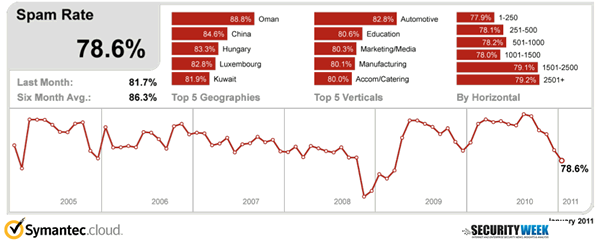Global Spam Declines to Lowest Level Since March 2009; Pharmaceutical Spam Takes a Dive
Following a two-week dramatic decline in spam levels, spam now accounts for 78.6 percent of all email traffic, the lowest rate since March 2009, when the global spam rate was 75.7 percent of all email traffic, according to Symantec’s January 2011 MessageLabs Intelligence Report released today. The volume of spam in circulation in January 2011 was 65.9% lower than for the same period one year ago in January 2010, when the spam rate was 83.9% of all email traffic, according to the report.
The recent decline, beginning December 25 and continuing through January 1, was the result of both a halt in the spam-sending activities of three botnets — Rustock, Lethic and Xarvester — and also unrest among pharmaceutical spam-sending gangs. During this two week period, spam volumes declined 58 percent from 80.2 billion spam emails per day to 33.5 billion spam emails each day, reminiscent of declines experienced when California-based ISP McColo was taken offline in late 2008 and continuing into early 2009.

“The closure of spam affiliate, Spamit, was partially responsible for the disruption to spam output,” said MessageLabs Intelligence Senior Analyst, Paul Wood, Symantec.cloud. “However, there are likely other factors at work, such as consolidation and restructuring of pharmaceutical spam operations which has led to instability in the market likely to be exploited as a business opportunity by other spam gangs. We expect to see more pharmaceutical spam in 2011 as new pharmaceutical spam brands emerge and botnets compete for their business.”
In May 2010, pharmaceutical spam experienced peak levels when up to 85% of spam was related to pharmaceutical products. However, in January 2011, MessageLabs Intelligence found that pharmaceutical spam accounted for about 59.1% of all spam.
Since the end of 2010, MessageLabs Intelligence has witnessed shifting patterns related to pharmaceutical spam-sending. Previously, the Canadian Pharmacy brand was the most prolific of the pharmaceutical spam brands however, when Spamit shut down in October 2010, the brand disappeared as affiliates switched to sending spam for other brands.
Botnets play a major role in spamming, and in 2010, spam-sending botnets were responsible for as much as 88 percent of the world’s spam falling to 77 percent by the end of the year. Previously, Rustock had been responsible for 47.5 percent of all spam, approximately 44.1 billion spam emails each day, making it the single, largest spam-sending botnet. Both Lethic and Xarvester accounted for less than 0.5 percent of all spam each.
“At various points during Rustock’s history, the botnet has often exhibited irregular spamming patterns by sending huge volumes of spam before going quiet for several weeks at a time,” Wood said. “But throughout 2010, its spamming pattern was more regular and it had been active non-stop until December 2010. Our investigation revealed no evidence of Rustock being disrupted in any way either by law enforcement or through other action.”
Since January 10, all three botnets have resumed their spam-sending operations but not at their previous levels. Since its return, Rustock, previously the single largest spam-sending botnet, is now responsible for 17.5 percent of all spam in January. The Bagle botnet has now replaced Rustock as the largest spam-sending botnet with output at 20 percent of all spam, but Rustock maintains its position as the largest sender of pharmaceutical spam with 80 percent of its output in January related to pharmaceuticals.
During the two weeks that Rustock was dormant, it was being used for click-fraud to generate fake referrals for click-through expenses.
Other report highlights from the January 2011 MessageLabs Intelligence Report:
Spam: In January 2011, the global ratio of spam in email traffic from new and previously unknown bad sources was 78.6 percent (1 in 1.3 emails), a decrease of 3.1 percentage points since December.
Viruses: The global ratio of email-borne viruses in email traffic from new and previously unknown bad sources was one in 364.8 emails (0.274 percent) in January, a decrease of .03 percentage points since December. In January, 65.1 percent of email-borne malware contained links to malicious websites, a decrease of 2.5 percentage points since December.
Endpoint Threats: Threats against endpoint devices such as laptops, PCs and servers may penetrate an organization in a number of ways, including drive-by attacks from compromised websites, Trojan horses and worms that spread by copying themselves to removable drives. Analysis of the most frequently blocked malware for the last month revealed that the Sality.AE virus was the most prevalent. Sality.AE spreads by infecting executable files and attempts to download potentially malicious files from the Internet.
Phishing: In January, phishing activity was 1 in 409.7 emails (0.244 percent), an increase of 0.004 percentage points since December.
Web security: Analysis of web security activity shows that 44.1 percent of malicious domains blocked were new in January, an increase of 7.9 percentage points since December. Additionally, 21.8 percent of all web-based malware blocked was new in January, a decrease of 3.1 percentage points since last month. MessageLabs Intelligence also identified an average of 2,751 new websites per day harboring malware and other potentially unwanted programs such as spyware and adware, a decrease of 21.5 percent since December.
Related: Security Focus on Consumer Electronics w/ Free Software Trial
Geographical Trends:
• Oman became the most spammed in October with a spam rate of 88.8 percent.
• In the US, 78.8 percent of email was spam and 78.3 percent in Canada. Spam levels in the UK were 78.7 percent.
• In The Netherlands, spam accounted for 79.4 percent of email traffic, while spam levels reached 77.8 percent in Germany, 79.8 percent in Denmark and 77.3 percent in Australia.
• Spam levels in Hong Kong reached 79.2 percent and 77.2 percent in Singapore. Spam levels in Japan were at 75.2 percent and 84.6 percent in China. In South Africa, spam accounted for 80.0 percent of email traffic.
• South Africa remained the most targeted by email-borne malware with 1 in 132.2 emails blocked as malicious in January.
• In the UK, 1 in 178.2 emails contained malware. In the US virus levels were 1 in 771.0 and 1 in 212.3 for Canada. In Germany, virus levels reached 1 in 501.1, 1 in 1,215.0 in Denmark, 1 in 858.7 for The Netherlands.
• In Australia, 1 in 667.4 emails were malicious and, 1 in 549.9 for Hong Kong, for Japan it was 1 in 1,233.0 compared with 1 in 733.3 for Singapore and 1 in 644.6 for China.
Vertical Trends:
• In January, the most spammed industry sector with a spam rate of 82.8 percent continued to be the Automotive sector.
• Spam levels for the Education sector were 80.6 percent, 79.1 percent for the Chemical & Pharmaceutical sector, 78.8 percent for IT Services, 77.9 percent for Retail, 77.2 percent for Public Sector and 77.4 percent for Finance.
• In January, Government/Public Sector remained the most targeted industry for malware with 1 in 40.9 emails being blocked as malicious.
• Virus levels for the Chemical & Pharmaceutical sector were 1 in 439.0, 1 in 497.8 for the IT Services sector, 1 in 714.9 for Retail, 1 in 194.3 for Education and 1 in 676.4 for Finance.
The January 2011 MessageLabs Intelligence Report provides greater detail on all of the trends and figures noted above, as well as more detailed geographical and vertical trends. The full report in PDF format is available here.









